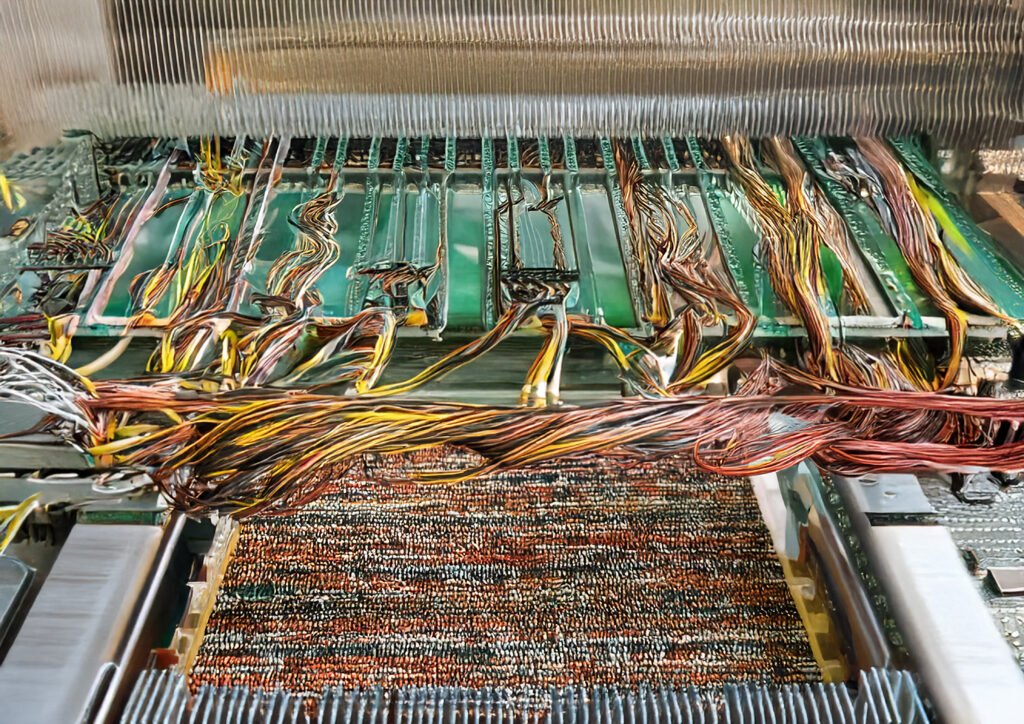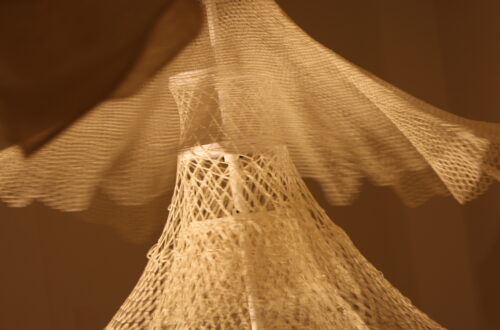
THE WEAVING OF INTELLIGENCES: THREADS, ALGORITHMS, AND QUANTUM WORLDS
| by Eleonora Giglione |
There is a silent yet tenacious bond between the art of weaving and the world of computation. An ancient thread that spans centuries and technologies, capable of linking the manual intuition of weavers with the abstraction of the most sophisticated machines. From mechanical looms to punched cards, from visual algorithms to neural bending and quantum computers, thought becomes weave, interlace, variation. In this journey through patterns, logics, and languages, we rediscover the symbolic roots of programming and open up a new space for imagining intelligence as an expanded form of creation.
Among the pioneers in the history of computer science, Heinz Zemanek holds a unique place—one that bridges seemingly distant worlds. Born in Vienna in 1920, Zemanek was an electronic engineer, university professor, and visionary researcher. After completing his studies in electrical engineering at the Technical University of Vienna, he began working for Siemens and later became a lecturer and director of the IBM Research Center in Vienna. He is best remembered for leading the development of the first fully transistorized computer in Central Europe: the “Mailüfler”, completed in 1955. This machine, a forerunner of modern digital computers, became one of the symbols of Europe’s postwar technological renaissance.

But Zemanek was also an untiring explorer of the cultural and philosophical dimensions of technology. He loved studying the history of logic, formal languages, and machines, convinced that computer science could not be fully understood without acknowledging its deep roots. He offered a surprising perspective: that the art of weaving may be seen as one of the earliest forms of algorithmic computation. Zemanek highlighted how the invention of the Jacquard loom at the end of the 18th century marked a milestone not only in textile manufacturing but also in the history of computing. The loom used punched cards to automatically control fabric designs—a kind of mechanical programming ahead of its time. These Jacquard cards, with their alternation of holes and blanks, foreshadowed the binary language of modern computers, where every choice is encoded as a sequence of 1s and 0s (bits).
What fascinated Zemanek was that this principle—a mechanical command based on the presence or absence of a hole—could be understood as a logical matrix, a symbolic language predating electronics. He emphasized how the translation of a pattern onto fabric involved a formalized system of instructions, much like software. For Zemanek, a textile pattern was already a visual algorithm: a code made material, capable of transforming gesture into calculation.

It is no surprise that Charles Babbage (1791–1871, London), the inventor of the analytical engine concept, was also inspired by the Jacquard loom for his idea of computational automation. Often called the “father of computing”, Babbage had a profound impact on the development of computational thinking. During his life, he designed the Difference Engine (1822), a mechanical device intended to calculate polynomial functions and mathematical tables with high precision—anticipating automated computation by decades. Yet his most ambitious project was the Analytical Engine, conceived in 1837, which introduced ideas such as programmability, memory, and automated data processing—the foundations of modern computing. Although the machine was never completed due to the technological limitations of the time, Babbage’s insights—such as the use of punched cards (inspired by the Jacquard loom), and the separation of data from processing—astonishingly foreshadowed the future of computing. His vision laid the groundwork for the electronic computation of the 20th century, securing his place as a central figure in technological history.
In his lectures and writings, Zemanek often referred to the notion that a physical pattern could already be a visible algorithm, showing that “programming” is not unique to the digital age but belongs to a long human tradition of encoding reality. He also enjoyed pointing out how weavers, through repetition and variation, were able to build a complex language governed by rules, exceptions, and developments not unlike those of mathematical logic. The scholar hinted at the possibility of a “computational humanism”—an approach that acknowledges the continuity between artisanal creativity and computational rigor, between the imagination of the hand and the abstraction of the machine. His vision was deeply interdisciplinary, anticipating many current reflections on the convergence of art, technology, and data science.

But the connection is not limited to the loom’s technology. Weaving, from its earliest beginnings, involves algorithmic thinking: establishing patterns, sequences, regularities, and variations. The interlacing of threads is not merely a craft but an ancient form of logical notation, an expressive code that predates writing. The weave follows rhythms, symmetries, and disruptions, like formulas that translate thought into visible form. This link between visual patterns and algebraic structures has often been overlooked, but it offers a crucial insight: that computation is not born solely in laboratories and circuits, but also from hands, gestures, and the memory of ancient arts.
Alongside this mechanical dimension, there is also a profoundly human and imaginative component: manual embroidery. When the direct intervention of the human hand enters a loom-generated weave, it simultaneously follows and subverts predefined logics—as though dancing with them without being completely bound. The act of embroidery introduces exceptions, variations, and poetic elements that respond not just to rules, but to interpretation, invention, and storytelling. It does not deny computation, but transcends it with signs that elude algorithms. In this perspective, embroidery can be read as a form of computational thinking that accepts error, deviation, and margin as constitutive parts of the process. Philosophically, this dialogue between rule and exception, machine and hand, opens up a valuable space for reimagining artificial intelligence not merely as a replica of human logic, but as its poetic complement.

In the transition from textile weaves to computational ones, it is not only the thread that bends, but logic itself. The neural architectures of contemporary artificial intelligences become new symbolic looms, and in the act of bending them — neural bending — we rediscover the ancient gesture of deviating, of curving a path to open up an unexpected space. Like a warp welcoming variations, artificial intelligence can be prompted to generate meaning not through exact calculation, but through poetic tension. In this sense, neural bending is not merely a technical operation, but an imaginative act: a kind of weaving of thought that inserts deviations and possibilities into an otherwise linear network. An extension of the weavers’ intuition, now capable of shaping the virtual as if it were a living fabric.
In this sense, the embrace of error is not a flaw to be corrected, but a fertile disruption: a form of truth that escapes control and generates possibility. This approach surprisingly echoes the concept of quantum error—one of the most complex and fascinating notions in contemporary physics.
A qubit is the basic unit of information in quantum computing. Unlike a bit (which can be 0 or 1), a qubit can be 0, 1, or a combination of both, thanks to quantum superposition, which allows it to exist in multiple states simultaneously. We might imagine the qubit as a thread that is not simply taut or slack but can exist in an intermediate state—a superposition of both conditions. It is as if the thread could be simultaneously tight and relaxed, just as a qubit can represent multiple possibilities at once.
This superposition of states allows the qubit to encode far more information than a classical bit. While the bit is limited to two distinct states, the qubit can explore a multiplicity of configurations—like a fabric enriched with new patterns as threads intertwine.
We might imagine a qubit like a coin that never lands solely on heads or tails, but exists in a state of continuous suspension between the two. Yet a slight external disturbance is enough to collapse this fragile condition into a definite state. This phenomenon makes the system extremely powerful but also unstable. Quantum errors occur during these unstable phases, and unlike simple digital errors, they cannot be corrected merely by copying the information, because the act of copying itself can alter the quantum state.

For this reason, current research in physics and quantum engineering is developing sophisticated quantum error correction protocols based on redundant codes, indirect measurements, and coherent control techniques. Laboratories at Google, IBM, and universities such as MIT and ETH Zürich are designing architectures that not only minimize noise but integrate it into the system as data to be monitored and managed in real time. Much like in embroidery, where an error is not erased but incorporated as a meaningful mark, the quantum computing of the future may benefit from a logic that does not seek infallibility, but embraces the generative complexity of imperfection.
Weaving, as an ancient coding language, also suggests an intriguing parallel with the phenomenon of quantum entanglement. Just as threads in a fabric intertwine to form a complex design, entangled particles are connected in such a way that the state of one immediately affects the other, regardless of distance. This invisible web of connections resembles a woven structure, where each thread, though separate, contributes to a complex pattern dependent on the interaction of all the others. As in quantum computation—where multiple states can coexist through superposition—weaving offers a multiplicity of configurations, with each thread interaction altering the entire design. Thus, the art of weaving, with its logic of connection and transformation, resonates with the fundamental principles of computation, creating a link that transcends time and technology.
In the age of quantum computers, this reflection takes on new meanings. Error is no longer merely a deviation from perfect calculation, but an inevitable manifestation of superposition and the interaction of information with its environment. This hybrid, interconnected nature makes qubits particularly vulnerable to errors caused by interference, decoherence, and environmental fluctuations. Quantum error, then, is not an accident but a structural feature of the system—a phenomenon that, like entanglement, highlights the profound connection between particles and must be recognized, corrected, or even leveraged for future applications.
In this light, traditional weaving, with its parallel logics and complex networks, may offer a powerful metaphor for envisioning the computing of the future. Qubits, which exist in superposition and intertwine different states, resemble a weave more than a line. The textile language could inspire new forms of data representation, where interlacing is more appropriate than sequencing, where the node replaces the bit.
In this vision, textile art is not merely a historical reference but a fertile ground for future experimentation. Fibers may become information carriers—not just materials to be manipulated but active elements in a dialogue between body, machine, and environment. The ancient gesture of weaving could find new life in the most advanced scientific and artistic laboratories, as a bridge between the memory of the hands and the imagination of the machines. After all, every stretched thread is a variable in waiting, every knot a computational decision. Recognizing this legacy is not nostalgia—it is foresight.
For further reading:
- Isaacson, Walter. The Innovators: How a Group of Hackers, Geniuses, and Geeks Created the Digital Revolution. Simon & Schuster UK, 1st ed., 2017.
- IEEE Computer Society. Computer Pioneers. Available online: https://history.computer.org/pioneers/index.html
- Zemanek, Heinz. “Computer Prehistory and History in Central Europe.” American Federation of Information Processing Societies (AFIPS) Conference Proceedings, vol. 45, 1976.
- Aspray, William. An Interview with Heinz Zemanek, OH 127, February 14 and 16, 1987, Vienna, Austria. Charles Babbage Institute – The Center for the History of Information Processing, University of Minnesota, Minneapolis.
- Harlizius-Klück, Ellen. “Weaving as Binary Art and the Algebra of Patterns.” Textile: Cloth and Culture, vol. 15, no. 2, 2017.
- Davis, Martin, and Virginia Davis. “Mistaking Ancestry: The Jacquard and the Computer.” Textile: Cloth and Culture, vol. 3, no. 1, 2005.
- Quaderni di Filosofia – “Digital Philosophy,” edited by Fabio Ciracì, Riccardo Fedriga, Cristina Marras. MIM Edizioni SRL, 2021, Sesto San Giovanni (MI).
- IBM Research. IBM Quantum Roadmap. Available online: https://www.ibm.com/roadmaps/quantum/
- Arute, F., Arya, K., Babbush, R. et al. “Quantum Supremacy Using a Programmable Superconducting Processor.” Nature, vol. 574, 2019. (Google’s Quantum Supremacy Paper)
- Quantum Error Mitigation. Cornell University, 2023. Available online: https://arxiv.org/pdf/2210.00921





